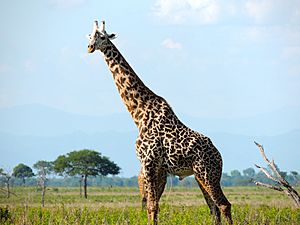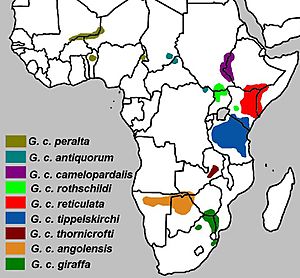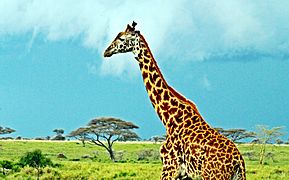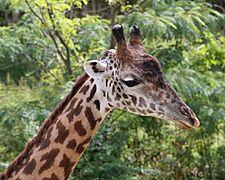Masai giraffe facts for kids
Quick facts for kids Masai giraffe |
|
|---|---|
 |
|
| A Masai giraffe in Serengeti, Tanzania | |
| Conservation status | |
| Scientific classification | |
 |
|
| Range map in blue |
The Masai giraffe (Giraffa camelopardalis tippelskirchii), also known as the Maasai giraffe or Kilimanjaro giraffe, is the largest type of giraffe. These amazing animals live in East Africa, mainly in central and southern Kenya and in Tanzania. You can spot them by their unique, jagged, star-like spots that go all the way down to their hooves. Male Masai giraffes often have a small bump on their forehead.
Contents
What is the Masai Giraffe?
The Masai giraffe is known for its special jagged spots and its home in southern Kenya and all of Tanzania. It is the biggest type of giraffe, making it the tallest land animal on Earth! Imagine standing next to an animal so tall it can look into a second-story window!
How Did the Masai Giraffe Get Its Name?
The Masai giraffe was first described in 1898 by a German zoologist named Paul Matschie. He gave it the scientific name Giraffa tippelskirchi. Later, scientists decided it was a subspecies of the common giraffe, so its name became Giraffa camelopardalis tippelskirchii.
The giraffe was named after a person called Herr von Tippelskirch. He was part of a German science trip in 1896. He brought back the skin of a female Masai giraffe from near Lake Eyasi in what is now northern Tanzania. This helped scientists identify it as a new type of giraffe.
Why Are Masai Giraffes Endangered?
Masai giraffes are considered an endangered species by the IUCN. This means they are at a high risk of disappearing from the wild. Their numbers have dropped by more than half in recent years.
- Poaching: One big reason for their decline is poaching, which is illegal hunting.
- Habitat Loss: Another reason is that their homes, or habitats, are shrinking. This happens when land is used for farming or building, leaving less space for giraffes to live and find food.
There are about 32,550 Masai giraffes left in the wild. Scientists study giraffes living both inside and outside protected areas. They found that adult giraffes are less likely to survive outside protected areas because of poaching. Baby giraffes, or calves, sometimes don't survive inside protected areas because of predators. The time of year a calf is born can also affect its survival, as can the presence of other animals like wildebeest and zebra.
Who is Helping Masai Giraffes?
Many groups are working hard to protect Masai giraffes. These include government groups like the Kenya Wildlife Service and Tanzania National Parks. Non-profit groups like PAMS Foundation and the Wild Nature Institute are also helping.
Some local communities are also creating special areas to protect wildlife, and these have been very good at helping giraffes. You can also find Masai giraffes in zoos, where they sometimes have babies, helping to keep their population going.
Gallery
-
Masai giraffe in Serengeti National Park, Tanzania
-
Detail of head, taken at Cincinnati Zoo and Botanical Garden
-
Close up of giraffe face in Masai Mara
Images for kids









